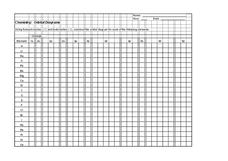CPO Science
Physics Skill and Practice Worksheets
Stop wasting energy searching for physics resources, this comprehensive collection of worksheets has you covered. Starting with introductions to the scientific method, dimensional analysis, and graphing data, these skills practice...
Curated OER
Make a Key to Identify Animals
In this developing a graphic organizer about animals instructional activity, students make a key to identify animals that live in water, does or doesn't have legs, eats meat, flies, grows from a tadpole, and has a shell. Students write...
NOAA
An Ocean of Energy
Young biologists trace the path of the sun's energy through marine ecosystems in the second part of this four-lesson plan series. Building on prior knowledge about producers, consumers, and decomposers students are introduced to the...
Curated OER
Aliphatic Reaction Pathways
Complete a graphic organizer of aliphatic reaction pathways. Chemistry aces fill in the chemical formulas of the different hydrocarbon compounds as they inspect products of different reactions. Using a graphic organizer gives learners a...
Curated OER
Cellular Respiration
In this cellular respiration worksheet, students use 14 terms from a word bank to complete a graphic organizer showing the relationship between the words.
Curated OER
Bonding Exercises
In this chemical compounds worksheet, young scholars complete a graphic organizer by determining the electron dot formula, molecular shape, bond angle, bond polarity, and molecular polarity for 7 given compounds.
Curated OER
Orbital Diagrams
In this orbital diagram worksheet, students complete a graphic organizer by determining the orbital diagram for the 22 elements given.
Curated OER
Finding Epicenters
In this earthquake learning exercise, students use the seismographs from different locations to determine the epicenter for the earthquake. Students plot the epicenter on a map. This learning exercise has 1 graphic organizer.
Wilderness Classroom
Pollution
Educate scholars on pollution—air, water, and land—with a series of lessons that begin with a thorough explanation of each type. Learners then take part in three activities to reinforce the importance of reducing pollution. They...
MENSA Education & Research Foundation
Hurricanes
Learn the ins and outs of hurricanes through a series of lessons answering, "What is a hurricane? How does it travel? How is one formed, measured, and named?" Information is presented through informative text and images, while...
Genesis Energy
Harnessing Solar Energy
How does additional daylight hours affect people and nature? With the help from the legend Maui and the Sun and a grand conversation, scholars complete a graphic organizer to distinguish between the positive and negative effects that...
Curated OER
KWL Graphic Organizer
In this graphic organizer worksheet, students fill in a KWL chart. They organize information using the "what I know, what I want to know, and what I learned" sections of the chart.
Curated OER
Rocks and Soils Graphic Organizer
In this earth science worksheet, students complete a chart by describing different types of rocks and soils. They search for the specified rocks in their world and describe them using the words in a word bank at the bottom of the page.
Curated OER
Upsetting Ecosystem Balance
In this ecosystem worksheet, students determine the affect on an ecosystem if different organisms are altered or removed. Students complete a graphic organizer.
Lerner Publishing
Meet the Dinosaurs
Take your class of youngsters on a prehistoric adventure with this four-lesson series on dinosaurs. Accompanying the Meet the Dinosaurs books by Don Lessem, these lessons engage children in writing their own dinosaur books, making...
Curated OER
Science – How Living Things are Grouped
In this classification of living things worksheet, students respond to 7 short answer, 10 true or false, 4 multiple choice, and 4 graphic organizer questions regarding how living things are grouped.
Curated OER
Nutritional Relationships Chart
Producers, Herbivores, Carnivores, Decomposers, oh my! Help organize the intricacies between these four types of eaters with this biology worksheet. Scientists display nutritional relationships in a graphic organizer. They place 15 terms...
Curated OER
Baby Animals
In this baby animal graphic organizer, students write in four examples of young animals that look like their parents, and two examples of young animals that look different from their parents.
Curated OER
Steps of the Scientific Method
This graphic organizer would be quite handy for making an overhead transparency and posting it for learners to view while doing any kind of sceince inquiry/experiment. This is a tried-and-true method, and is very important for any...
Curated OER
Network Tree
In this network tree graphic organizer instructional activity, learners record details about the inter-connectedness of a topic of their choice by filling in the 9 ovals.
Curated OER
How Do Scientists Classify Organisms?
In this classification worksheet, students write in examples of the 6 kingdoms: archaebacteria, eubacteria, protists, fungi, plants, and animals. This worksheet is a graphic organizer.
Curriculum Corner
Coniferous and Deciduous Trees
What are the differences between coniferous and deciduous trees? Supplement your tree lessons with a set of activities that has learners describing, naming, comparing, and reading about deciduous and coniferous trees. The activities are...
Student Handouts
Before-and-After Chart
Keep track of what happens before and after an event, moment in a story, and so on, with a clear graphic organizer. Learners can note down four things that happen before and four that happen after on this chart.
abcteach
Flowers for Algernon, by Daniel Keyes
Looking for materials to accompany your study of Flowers for Algernon, by Daniel Keyes? Look no further! Included here is everything you need to go alongside your unit: worksheets, graphic organizers, writing assignments, an assessment,...

























